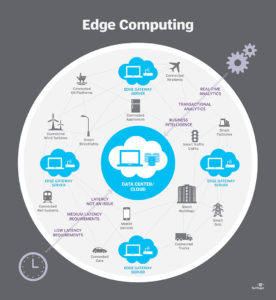Edge computing has come a long way. Initially conceived as a way to address bandwidth issues for data traveling long distances, edge computing systems now focus largely on powering and processing Internet of Things (IoT) devices and applications. The continued explosion of IoT has contributed to the growth of edge computing, and has made it an essential aspect of IT topology.
Edge Computing 101
In a recent article, NetworkWorld discussed the origins of edge computing, stating that it essentially processes data closer to the place at which that data is either produced or consumed. That place is known as the “edge.” There are many benefits of processing data closer to its source, including faster processing, less lag time and lower costs for businesses and users.
IoT Has Sped the Growth of Edge Computing
The Internet of Things was one of the primary reasons for the move to the edge. IoT devices are continually delivering or receiving data to and from the cloud, and they typically generate huge amounts of data. And the category of IoT devices includes more than just your fitness tracker or smart thermostat. IoT devices are used in critical roles in industries such as power utilities, healthcare and manufacturing.
So as IoT has grown faster than anyone anticipated, edge computing has become an increasingly valuable tool. It will likely continue to expand as server and storage demands increase in the coming years.
How Will 5G Impact Edge Computing?
5G wireless technologies are being rolled out around the world, promising high bandwidth and low latency for applications. Shouldn’t this hinder the growth of edge computing? Exactly the opposite: many carriers are incorporating edge computing into their 5G offerings to offer even faster speeds. Therefore, as 5G is deployed, edge computing will continue its unprecedented growth, probably for years to come.
Ready to Move to the Edge?
Vaultas is a premier provider of edge colocation for cloud service providers. Our carrier neutral business model enables easy access and low latency, high capacity bandwidth. Further, our low power rates and proximity to major markets creates a low operating cost for maximum margins. Contact us to learn more.
Vaultas is a premier provider of IT solutions, providing data storage and backup, disaster recovery and business continuity services, hosting, colocation, cloud storage, data center consulting and more. Our data centers are located in Minneapolis/St. Paul, Alexandria and St. Cloud, MN, and Milwaukee, WI. Contact us to get started.


